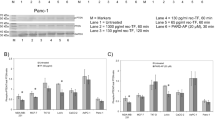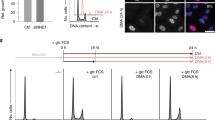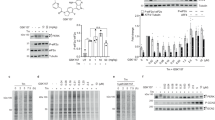Abstract
The MDR1 gene encoding the multidrug pump P-glycoprotein is transcriptionally activated in response to diverse extracellular stimuli, including the tumor promoting phorbol ester, 12-O-tetradecanoylphorbol-13-acetate (TPA). However, the signal transduction pathway responsible is unknown. Downstream of protein kinase C (PKC), the effects of TPA are often mediated by the Raf-1/MEK/ERK mitogen-activated protein kinase (MAPK) cascade, and Raf-1 has been implicated in MDR1 induction by serum and mitogens. Therefore, we examined the potential role of MAPK activation in TPA-mediated MDR1 induction in human leukemia K562 cells. MDR1 mRNA expression was significantly increased by TPA in the concentration range of 4 – 100 nM, with a maximal response 5 – 10 h after TPA addition. TPA-mediated MDR1 induction was inhibited by several PKC inhibitors including staurosporine, H7 and calphostin C. TPA stimulated the subcellular translocation of PKCα from the cytosol to the membrane and nucleus but did not affect other PKC isozymes. TPA also activated the Raf1/MEK/ERK cascade and activated another MAPK member, p38, but not JNK. In order to determine the potential role of MAPKs in MDR1 induction by TPA, specific inhibitors were utilized. The MEK inhibitor PD 098059, as well as the PKC inhibitors, completely blocked TPA-mediated ERK activation. However, under identical conditions, MDR1 induction by TPA was completely unaffected by PD 098059. Furthermore, SB 202190, which effectively inhibited TPA-mediated p38 activation, failed to inhibit TPA-induced MDR1 mRNA expression. These data demonstrate that MDR1 induction by TPA occurs via a PKC-dependent mechanism that operates independently of ERK, p38 or JNK pathways, and thus have important implications for understanding the mechanisms of MDR1 induction by extracellular stimuli.
This is a preview of subscription content, access via your institution
Access options
Subscribe to this journal
Receive 50 print issues and online access
$259.00 per year
only $5.18 per issue
Buy this article
- Purchase on Springer Link
- Instant access to full article PDF
Prices may be subject to local taxes which are calculated during checkout







Similar content being viewed by others
References
Abraham I. . 1996 Multidrug Resistance in Cancer Cells: Molecular, Biochemical, Physiological and Biological Aspects. Gupta S and Tsuruo T (eds).. John Wiley & Sons, Ltd: Chichester, UK pp 273–282.
Bradley G and Ling V. . 1994 Cancer Metastasis Rev. 13: 223–233.
Bruns RF, Miller FD, Merriman RL, Howbert JJ, Heath WF, Kobayashi E, Takahashi I, Tamaoki T and Nakano H. . (1991) Biochem. Biophys. Res. Commun. 176: 288–293.
Buchner K. . 1995 Eur. J. Biochem. 228: 211–221.
Burt RK, Garfield S, Johnson K and Thorgeirsson SS. . 1988 Carcinogenesis 9: 2329–2332.
Chaudhary PM and Roninson IB. . 1992 Oncology Res. 4: 281–290.
Chen Q, Kinch MS, Lin TH, Burridge K and Juliano RL. . 1994 J. Biol. Chem. 269: 26602–26605.
Chin KV, Ueda K, Pastan I and Gottesman, MM. . 1992 Science 255: 459–462.
Chin KV, Pastan I and Gottesman, MM. . 1993 Adv. Cancer Res. 60: 157–180.
Cobb MH and Goldsmith EJ. . 1995 J. Biol. Chem. 270: 14843–14846.
Cornwell MM. . 1996 Multidrug Resistance in Cancer Cells: Molecular, Biochemical, Physiological and Biological Aspects. Gupta S and Tsuruo T (eds). John Wiley & Sons, Ltd: Chichester, UK pp 39–48.
Cornwell MM and Smith DE. . 1993 J. Biol. Chem. 268: 15347–15350.
Daum G, Eisenmann-Tappe I, Fries HW, Troppmair J and Rapp UR. . 1994 Trends Biochem. Sci. 19: 474–480.
Dudley DT, Pang L, Decker SJ, Bridges AJ and Saltiel AR. . 1995 Proc. Natl. Acad. Sci. USA 92: 7686–7689.
Frantz B, Klatt T, Pang M, Parsons J, Rolando A, Williams H, Tocci MJ, O'Keefe SJ and O'Neill EA. . 1998 Biochemistry 37: 13846–13853.
Gallagher TF, Seibel GL, Kassis S, Laydon JT, Blumenthal MJ, Lee JC, Lee D, Boehm JC, Fier-Thompson SM, Abt JW, Soreson ME, Smietana JM, Hall RF, Garigipati RS, Bender PE, Erhard KF, Krog AJ, Hofmann GA, Sheldrake PL, McDonnell PC, Kumar S, Young PR and Adams JL. . 1997 Bioorganic Medicinal Chem. 5: 49–64.
Germann UA. . 1996 Eur. J. Cancer 32A: 927–944.
Germann UA and Chambers TC. . 1998 Cytotechnology 27: 31–60.
Gottesman MM, Willingham MC, Thiebaut F and Pastan I. . 1991a Molecular and Cellular Biology of Multidrug Resistance in Tumor Cells. Roninson IB, (ed). New York: Plenum Press pp 279–289.
Gottesman MM, Goldstein LJ, Fojo A, Galski H and Pastan I. . 1991b Molecular and Cellular Biology of Multidrug Resistance in Tumor Cells. Roninson IB, (ed). New York: Plenum Press pp 291–301.
Glazer RI and Rohlff C. . 1994 Breast Cancer Res. Treatment 31: 263–271.
Ignatova TN and Beck WT. . (1996) Multidrug Resistance in Cancer Cells: Molecular, Biochemical, Physiological and Biological Aspects. Gupta S and Tsuruo T (eds). John Wiley & Sons, Ltd: Chichester, UK pp 177–191.
Ince, TA and Scotto KW. . 1997 Encyclopedia of Cancer. Vol. 3. Bertino JR (ed.). Academic Press: San Diego, CA. pp 1751–1764.
Izquierdo MA, Scheffer GL, Flens MJ, Schroeijers, AB, van der Valk P and Scheper RJ. . 1996 Eur. J. Cancer 32A: 979–984.
Janosch P, Schellerer M, Seitz T, Reim P, Eulitz M, Brielmeier M, Kolch W, Sedivy JM and Mischak H. . 1996 J. Biol. Chem. 271: 13868–13874.
Kawamoto S and Hidaka H. . 1984 Biochem. Biophys. Res. Commun. 125: 258–263.
Kolch W, Heidecker G, Kochs G, Hummel R, Vahidi H, Mischak H, Finkenzeller G, Marme D and Rapp UR. . 1993 Nature 364: 249–252.
Kobayashi E, Nakano H, Morimoto M and Tamaoki T. . 1989 Biochem. Biophys. Res. Commun. 159: 548–553.
Kyriakis JM and Avruch J. . 1996 J. Biol. Chem. 271: 24313–24316.
Loe DW, Deeley RG and Cole SP. . 1996 Eur. J. Cancer 32A: 945–957.
Li S and Sedivy JM. . 1993 Proc. Natl. Acad. Sci. USA 90: 9247–9251.
Liu JP. . 1996 Mol. Cell. Endocrin. 116: 1–29.
McCoy C, Smith DE and Cornwell MM. . 1995 Mol. Cell. Biol. 15: 6100–6108.
Murray NR, Baumgardner GP, Burns, DJ and Fields AP. . 1993 J. Biol. Chem. 268: 15847–15853.
Noonan KE and Roninson IB. . 1991 Molecular and Cellular Biology of Multidrug Resistance in Tumor Cells. Roninson IB, (ed). New York: Plenum Press pp 319–333.
Ohkawa T, Kijima H, Irie A, Horng G, Kaminski A, Tsai J, Kashfian BI and Scanlon KJ. . 1996 Multidrug Resistance in Cancer Cells: Molecular, Biochemical, Physiological and Biological Aspects. Gupta S and Tsuruo T (eds). John Wiley & Sons, Ltd: Chichester, UK pp 413–433.
Osborn MT and Chambers TC. . 1996 J.Biol. Chem. 271: 30950–30955.
Rischin D and Ling V. . 1993 Leukemia Advances Research and Treatment. Freireich EJ and Kantarjian H (eds). Boston: Kluwer Academic Publishers. pp 269–293.
Simon C, Goepfert H and Boyd D. . 1998 Cancer Res. 58: 1135–1139.
Tamaoki T, Nomoto H, Takahashi I, Kato Y, Morimoto M and Tomita F. . 1986 Biochem. Biophys. Res. Commun. 135: 397–402.
Thorgeirsson SS, Gant TW and Silverman JA. . 1994 Cancer Treatment Res. 73: 57–68.
Ueda K, Clark DP, Chen C, Roninson IB, Gottesman MM and Pastan I. . 1987 J. Biol. Chem. 262: 505–508.
Wang HG, Rapp UR and Reed JC. . 1996 Cell 87: 629–638.
Zheng B, Chambers TC, Raynor RL, Markham PN, Gebel HM, Vogler WR and Kuo JF. . 1994 J. Biol. Chem. 269: 12332–12338.
Zhou G and Kuo MT. . 1997 J. Biol. Chem. 272: 15174–15183.
Acknowledgements
This work was supported in part by National Institutes of Health Grant CA75577 from the National Cancer Institute to TC Chambers.
Author information
Authors and Affiliations
Rights and permissions
About this article
Cite this article
Osborn, M., Berry, A., Ruberu, M. et al. Phorbol ester induced MDR1 expression in K562 cells occurs independently of mitogen-activated protein kinase signaling pathways. Oncogene 18, 5756–5764 (1999). https://doi.org/10.1038/sj.onc.1202943
Received:
Revised:
Accepted:
Published:
Issue Date:
DOI: https://doi.org/10.1038/sj.onc.1202943
Keywords
This article is cited by
-
Protein kinase Cα protects against multidrug resistance in human colon cancer cells
Molecules and Cells (2012)
-
Cediranib (recentin, AZD2171) reverses ABCB1- and ABCC1-mediated multidrug resistance by inhibition of their transport function
Cancer Chemotherapy and Pharmacology (2009)
-
Increased p38-MAPK is responsible for chemotherapy resistance in human gastric cancer cells
BMC Cancer (2008)
-
Characterization of vinblastine-induced Bcl-xL and Bcl-2 phosphorylation: evidence for a novel protein kinase and a coordinated phosphorylation/dephosphorylation cycle associated with apoptosis induction
Oncogene (2005)



